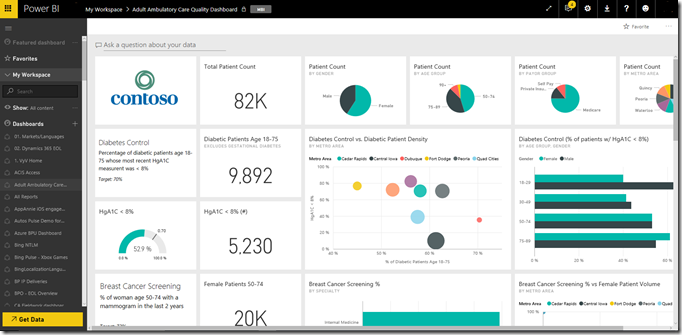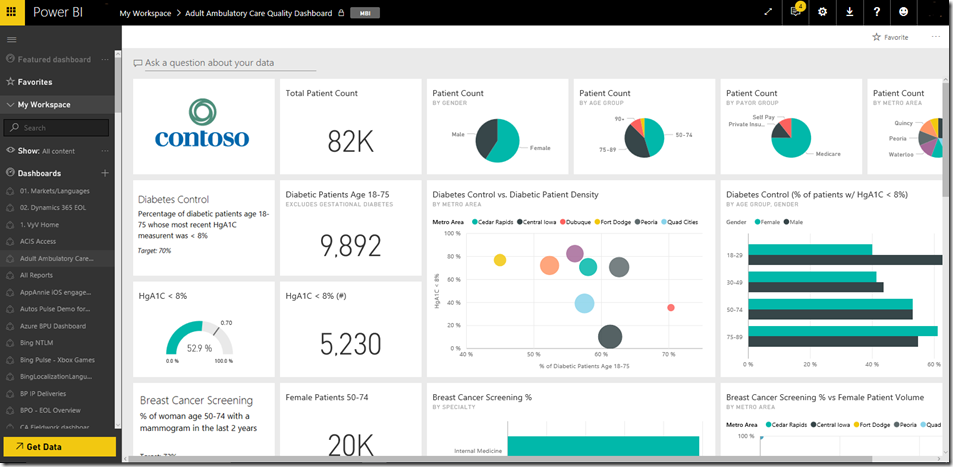Microsoft Power BI - Choosing the Offering that Meets Your Needs
Microsoft Power BI is a suite of business analytics tools to analyze data and share insights. With free Power BI desktop tool, you can easily create intuitive reports using a variety of data sources and publish them to your Power BI dashboard. You can then view your reports in the browser or the Power BI mobile app for Windows, iOS or Android. However, one big upfront question is, which Power BI offering is the right option for you. The answer to the question depends on your requirements and pricing. Below is a brief summary of the Power BI offerings available today. For more information on Power BI, please check several resources listed at the bottom of the post.
Option #1 - Sharing reports hosted at Microsoft Power BI site, with anonymous access
Embedding Power BI reports or tiles into your web page, without the Power BI Embedded Azure service, is done by using the Power BI API. When you want to share your reports for all users (including external users), you can simply embed with anonymous access.
Option #2 - Sharing dashboards and reports hosted at Microsoft Power BI site, with Azure AD authentication (different from #1 above)
When you want to share your reports in your same organization, you can embed the reports, with Azure AD authentication. This offering, sometimes referred to as SaaS/AAD, supports on-premises data access. Also, SaaS/AAD supports scheduled data refresh. The user who views the reports must login using their own Azure AD account. SaaS/AAD embedding requires to have Power BI tenant and usage is covered by user license.
Option #3 - Sharing reports using Power BI Embedded through Azure Portal
This offering, sometimes referred to as PaaS/Power BI Embedded Azure service, is a separate offering from the Power BI service. The embedding solution must collaborate with ISV existing authentication methods safely. It's also necessary for users to be able to use ISV applications without the extra purchase or licensing of a Power BI subscription. This option currently doesn’t support on-premises data access but it should have SQL server (AS and OLTP) on-premises data access support later on. It doesn’t support scheduled data refresh. This service is charged per report session.
Option #4 - Creating Power BI Content Packs
ISVs can build template content packs that allow customers to connect and instantiate with their own accounts. As domain experts, they can unlock the data in a way that is easily consumable by business users. The content packs offer ad hoc monitoring and analysis to your customers without investing heavily in reporting infrastructure. These template content packs are intended to eventually become publicly available in the Power BI content pack gallery (app.powerbi.com/getdata/services).
The general process to develop and submit an template content pack involves multiple steps - Complete a nomination through Azure Certified; Build content in the Power BI Desktop; Create a dashboard in PowerBI.com; Test the content pack yourself within your organization; Submit the content to Power BI for publishing.
Power BI Service
https://powerbi.microsoft.com/en-us/developers/
https://powerbi.microsoft.com/en-us/documentation/powerbi-service-share-unshare-dashboard/
https://powerbi.microsoft.com/en-us/mobile/
Power BI Embedded Azure Service
https://azure.microsoft.com/en-us/documentation/articles/power-bi-embedded-faq/
https://azure.microsoft.com/en-us/documentation/articles/power-bi-embedded-get-started/
https://azure.microsoft.com/en-us/documentation/articles/power-bi-embedded-iframe/
https://azure.microsoft.com/en-us/documentation/articles/power-bi-embedded-rls/
Content Pack
https://powerbi.microsoft.com/en-us/documentation/powerbi-developer-content-pack-overview/
Power BI and Power BI Embedded Pricing
https://powerbi.microsoft.com/en-us/pricing/?b=1
https://azure.microsoft.com/en-us/pricing/details/power-bi-embedded/

